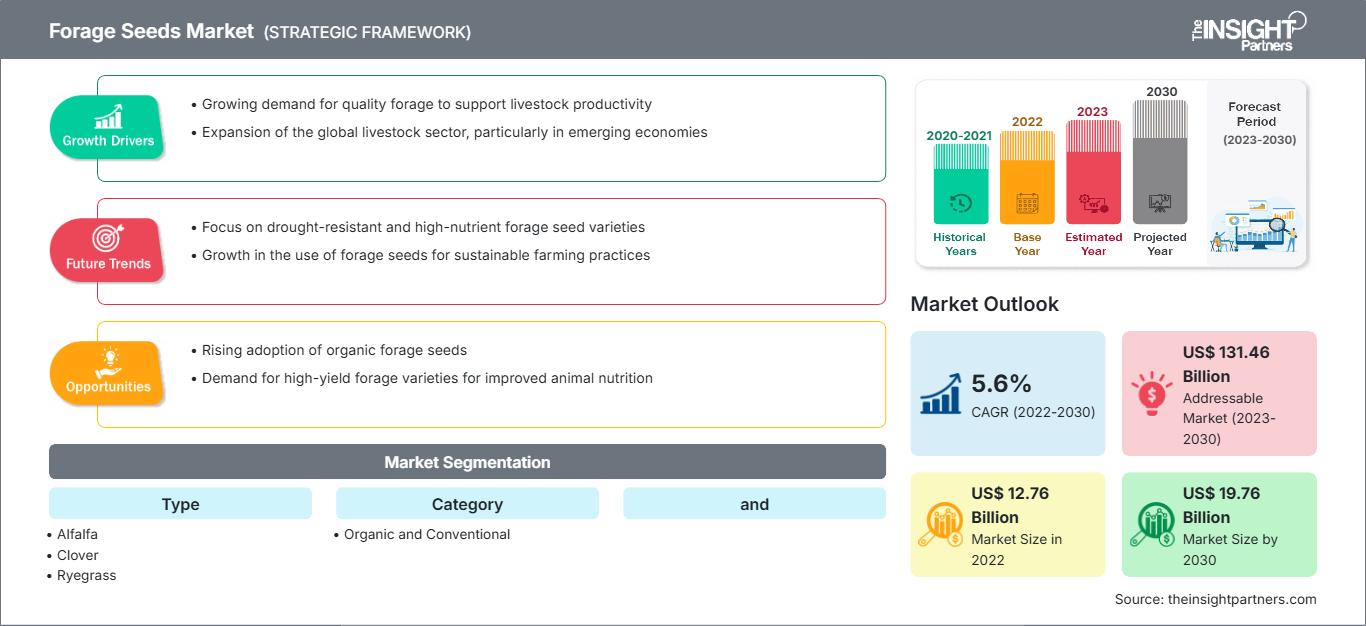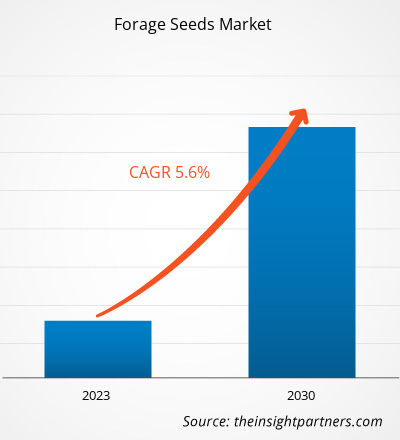[Rapporto di ricerca] Si prevede che il mercato crescerà da 12.757,00 milioni di dollari nel 2022 a 19.755,46 milioni di dollari entro il 2030; si prevede che registrerà un CAGR del 5,6% dal 2022 al 2030.
Approfondimenti di mercato e punto di vista degli analisti:
I mangimi convenzionali contengono spesso elevate quantità di sostanze chimiche che compromettono la qualità della carne quando viene consumata dagli animali. A lungo termine, il consumo di tale carne provoca vari disturbi di salute. Per superare questo problema, i produttori stanno sviluppando mangimi biologici privi di additivi chimici. Gli animali che si nutrono di tali mangimi offrono carne dall'elevato valore nutrizionale. Pertanto, i consumatori spesso trovano nei prodotti biologici e naturali alternative più sane ai prodotti convenzionali. I consumatori sono principalmente propensi a preferire i prodotti biologici, il che ha incoraggiato i produttori a investire massicciamente in prodotti realizzati con componenti biologici. Inoltre, l'accesso più accessibile a infinite informazioni grazie a Internet ha reso i consumatori sempre più consapevoli delle proprie esigenze di salute, determinando una crescente domanda di mangimi biologici. Pertanto, si prevede che la crescente preferenza per i mangimi biologici diventerà una tendenza significativa nel mercato dei semi foraggeri durante il periodo di previsione.
Fattori di crescita e sfide:
I miglioramenti tecnologici nella genetica dei semi offrono un'opportunità di crescita per il mercato globale dei semi foraggeri. I produttori di semi hanno sviluppato diverse varietà o tratti di semi, come semi ibridi, OGM, non OGM e biologici, con sviluppi tecnologici. La preferenza degli agricoltori per queste varietà transgeniche sta lentamente aumentando in diverse regioni di coltivazione di foraggi per ridurre al minimo le perdite di raccolto dovute a erbe infestanti e malattie e migliorare la qualità dei semi. I semi ibridi vengono sviluppati mediante una speciale impollinazione incrociata attentamente controllata di due diverse piante madri della stessa specie per produrre nuovi tratti che non possono essere creati dalla consanguineità di due piante uguali. Solitamente, i semi ibridi vengono impollinati manualmente tramite impollinazione incrociata.
I semi OGM sono prodotti mediante ingegneria genetica, alterando il materiale genetico di un organismo. I semi OGM vengono coltivati in laboratorio utilizzando moderne tecniche biotecnologiche. I semi non OGM, invece, vengono coltivati mediante impollinazione. I semi biologici sono considerati semi non OGM. I semi biologici sono prodotti naturalmente senza l'ausilio di pesticidi, fertilizzanti o altre sostanze chimiche. Questi semi sono resistenti alle malattie e hanno una maggiore capacità di prosperare in condizioni avverse.
Queste tecniche di miglioramento genetico consentono lo sviluppo di nuove varietà di semi con le caratteristiche desiderate, modificando il DNA dei semi e delle cellule vegetali. Questi miglioramenti tecnologici stanno contribuendo ad affrontare le sfide che gli agricoltori devono affrontare durante la coltivazione di semi foraggeri. Pertanto, si prevede che i costanti miglioramenti tecnologici creeranno opportunità redditizie nel mercato dei semi foraggeri nei prossimi anni.
Personalizza questo rapporto in base alle tue esigenze
Potrai personalizzare gratuitamente qualsiasi rapporto, comprese parti di questo rapporto, o analisi a livello di paese, pacchetto dati Excel, oltre a usufruire di grandi offerte e sconti per start-up e università
Mercato dei semi foraggeri: Approfondimenti strategici

-
Ottieni le principali tendenze chiave del mercato di questo rapporto.Questo campione GRATUITO includerà l'analisi dei dati, che vanno dalle tendenze di mercato alle stime e alle previsioni.
Segmentazione e ambito del rapporto:
Il "Mercato globale dei semi foraggeri" è segmentato in base a tipologia, categoria, bestiame e area geografica. In base alla tipologia, il mercato dei semi foraggeri è segmentato in [erba medica, trifoglio (bianco, rosso, ibrido e altri), loietto (loietto annuale, loietto perenne, loietto italiano e loietto ibrido), fleolo, sorgo, bromo, ginestrino, fagiolo dall'occhio, festuca dei prati e altri]. In base alla categoria, il mercato è segmentato in biologico e convenzionale. In base al bestiame, il mercato dei semi foraggeri è segmentato in ruminanti, pollame, suini e altri. Il mercato dei semi foraggeri, in base all'area geografica, è segmentato in Nord America (Stati Uniti, Canada e Messico), Europa (Germania, Francia, Italia, Regno Unito, Russia e resto d'Europa), Asia-Pacifico (Australia, Cina, Giappone, India, Corea del Sud e resto dell'Asia-Pacifico), Medio Oriente e Africa (Sudafrica, Arabia Saudita, Emirati Arabi Uniti e resto del Medio Oriente e dell'Africa) e America meridionale e centrale (Brasile, Cile e resto dell'America meridionale e centrale).
Analisi segmentale:
In base al bestiame, il mercato dei semi foraggeri è segmentato in ruminanti, pollame, suini e altri. Il segmento dei ruminanti ha detenuto la quota maggiore del mercato dei semi foraggeri nel 2022 e si prevede che registrerà un tasso di crescita significativo durante il periodo di previsione. I ruminanti includono bovini, ovini, caprini e bufali. Il foraggio è la principale fonte di proteine, fibre ed energia per i ruminanti. I foraggi leguminosi come l'erba medica e il trifoglio forniscono il 75% delle proteine grezze ai ruminanti. Le erbe foraggere forniscono elevate quantità di fibre ai ruminanti. Il foraggio riduce anche il costo complessivo dell'alimentazione ruminale. Pertanto, gli allevatori di bestiame utilizzano solitamente il foraggio insieme ai mangimi. La crescente consapevolezza dell'importanza di un'alimentazione specifica per i ruminanti, in particolare vacche da latte, capre e pecore e bovini da carne, sta stimolando la domanda di foraggio, stimolando così la crescita del mercato dei semi foraggeri.
Analisi regionale:
In base alla geografia, il mercato dei semi foraggeri è segmentato in cinque regioni chiave: Nord America, Europa, Asia-Pacifico, America meridionale e centrale e Medio Oriente e Africa. Il mercato globale dei semi foraggeri è stato dominato dal Nord America e si stima che nel 2022 raggiungesse un valore di circa 5.000 milioni di dollari. Il Nord America è uno dei mercati più importanti per i semi foraggeri a causa dell'aumento della domanda di foraggio come mangime, del consumo di carne e delle condizioni meteorologiche, nonché dell'aumento del consumo di prodotti zootecnici nonostante l'aumento dei prezzi, la consolidata industria dei mangimi e l'agricoltura. Un numero crescente di persone che optano per prodotti ricchi di proteine e più sani, l'aumento del reddito disponibile, i cambiamenti nello stile di vita e nelle abitudini alimentari contribuiscono a un'impennata della domanda di carne ricca di proteine negli Stati Uniti, in Canada e in Messico. Pertanto, con l'aumento del consumo di prodotti a base di carne, la domanda di mangimi per animali aumenta e alimenta ulteriormente il mercato dei semi foraggeri. La regione rappresenta uno dei maggiori produttori di mangimi per animali dell'intera regione. Secondo il rapporto di Alltech Global, nel 2020 la regione ha prodotto oltre 254 milioni di tonnellate di mangimi per animali. La produzione di massa di mangimi per animali in Nord America e le crescenti preoccupazioni per la sicurezza alimentare, in particolare per quanto riguarda carne e latticini, hanno portato a un aumento del consumo di mangimi nutrizionali per animali, come i foraggi, nella regione.
Si prevede che anche il significativo aumento dell'allevamento bovino in Nord America stimolerà la domanda di mangimi per animali, come i foraggi, durante il periodo di previsione. Ad esempio, secondo la Foothills Forage & Grazing Association, il patrimonio bovino canadese ammontava a 12,29 milioni di capi al 1° luglio 2021, con un aumento dello 0,2% rispetto al 1° luglio 2020. L'aumento è attribuito alla crescente domanda di prodotti a base di carne fresca, che ha fatto impennare le importazioni di bestiame bovino. Inoltre, secondo il rapporto del Dipartimento dell'Agricoltura degli Stati Uniti (UDSA), nel 2021 il Nord America ha registrato oltre 114 milioni di capi di bestiame bovino e oltre 109 milioni di capi di maiale nella regione. Pertanto, l'aumento del patrimonio bovino e la crescente domanda di mangimi sani per animali determinano la domanda di semi foraggeri in tutta la regione.
Sviluppi del settore e opportunità future:
Di seguito sono elencate varie iniziative intraprese dai principali attori che operano nel mercato dei semi foraggeri:
- Nel novembre 2022, UPL Ltd., fornitore globale di soluzioni agricole sostenibili, ha annunciato che la sua azienda, Advanta Seeds UK, e Bunge avevano firmato un accordo per acquisire una quota del 20% ciascuna in SEEDCORP|HO. Questo investimento previsto rientra nell'obiettivo OpenAg del Gruppo UPL di promuovere la collaborazione per offrire un pacchetto completo di soluzioni per gli agricoltori.
- Nell'ottobre 2022, KKR, una società di investimento globale, e UPL Limited, un fornitore globale di soluzioni per l'agricoltura, hanno annunciato la firma di accordi definitivi in base ai quali KKR investirà 300 milioni di dollari USA per una partecipazione del 13,33% in Advanta Enterprises Limited, una sussidiaria di Ltd.
Impatto del COVID-19:
La pandemia di COVID-19 ha colpito economie e settori in diversi paesi. Divieti di viaggio, lockdown e chiusure aziendali nei principali paesi del Nord America, Europa, Asia-Pacifico (APAC), America meridionale e centrale (SAM) e Medio Oriente e Africa (MEA) hanno influito negativamente sulla crescita di vari settori, tra cui l'agricoltura e l'industria dei mangimi per animali. La chiusura delle unità produttive ha interrotto le catene di approvvigionamento globali, i programmi di consegna, le attività produttive e le vendite di vari prodotti essenziali e non essenziali. Diverse aziende hanno annunciato possibili ritardi nelle consegne dei prodotti e un crollo delle vendite future dei loro prodotti nel 2020. Inoltre, i divieti imposti da vari governi in Europa, Asia e Nord America sui viaggi internazionali hanno costretto le aziende a sospendere temporaneamente i loro piani di collaborazione e partnership. Tutti questi fattori hanno ostacolato l'industria dei mangimi per animali nel 2020 e all'inizio del 2021, frenando così la crescita del mercato dei semi foraggeri.
Approfondimenti regionali sul mercato dei semi foraggeri
Le tendenze regionali e i fattori che influenzano il mercato dei semi foraggeri durante il periodo di previsione sono stati ampiamente spiegati dagli analisti di The Insight Partners. Questa sezione illustra anche i segmenti e la geografia del mercato dei semi foraggeri in Nord America, Europa, Asia-Pacifico, Medio Oriente e Africa, America meridionale e centrale.
Ambito del rapporto sul mercato dei semi foraggeri
| Attributo del rapporto | Dettagli |
|---|---|
| Dimensioni del mercato in 2022 | US$ 12.76 Billion |
| Dimensioni del mercato per 2030 | US$ 19.76 Billion |
| CAGR globale (2022 - 2030) | 5.6% |
| Dati storici | 2020-2021 |
| Periodo di previsione | 2023-2030 |
| Segmenti coperti |
By Tipo
|
| Regioni e paesi coperti |
Nord America
|
| Leader di mercato e profili aziendali chiave |
|
Densità degli operatori del mercato dei semi foraggeri: comprendere il suo impatto sulle dinamiche aziendali
Il mercato dei semi foraggeri è in rapida crescita, trainato dalla crescente domanda da parte degli utenti finali, dovuta a fattori quali l'evoluzione delle preferenze dei consumatori, i progressi tecnologici e una maggiore consapevolezza dei benefici del prodotto. Con l'aumento della domanda, le aziende stanno ampliando la propria offerta, innovando per soddisfare le esigenze dei consumatori e sfruttando le tendenze emergenti, alimentando ulteriormente la crescita del mercato.

- Ottieni il Mercato dei semi foraggeri Panoramica dei principali attori chiave
Panorama competitivo e aziende chiave:
UPL Ltd, DLF Seeds AS, Corteva Inc, Limagrain UK Ltd, S&W Seed Co, Deutsche Saatveredelung AG, Cerience, Allied Seed LLC, MAS Seeds SA e Syngenta AG sono tra i principali attori che operano nel mercato globale dei semi foraggeri. Questi produttori di semi foraggeri offrono soluzioni all'avanguardia con caratteristiche innovative per offrire un'esperienza superiore agli agricoltori e al loro bestiame.
- Analisi storica (2 anni), anno base, previsione (7 anni) con CAGR
- Analisi PEST e SWOT
- Valore/volume delle dimensioni del mercato - Globale, Regionale, Nazionale
- Industria e panorama competitivo
- Set di dati Excel
Report recenti
Rapporti correlati
Testimonianze
Motivo dell'acquisto
- Processo decisionale informato
- Comprensione delle dinamiche di mercato
- Analisi competitiva
- Analisi dei clienti
- Previsioni di mercato
- Mitigazione del rischio
- Pianificazione strategica
- Giustificazione degli investimenti
- Identificazione dei mercati emergenti
- Miglioramento delle strategie di marketing
- Aumento dell'efficienza operativa
- Allineamento alle tendenze normative






















 Ottieni un campione gratuito per - Mercato dei semi foraggeri
Ottieni un campione gratuito per - Mercato dei semi foraggeri